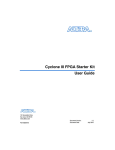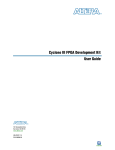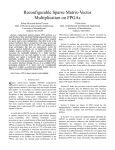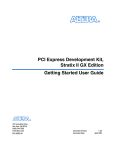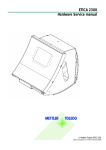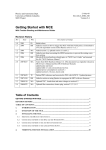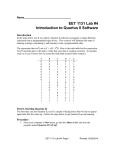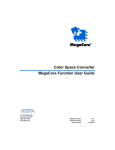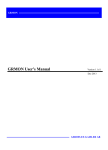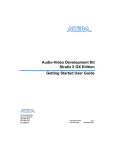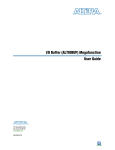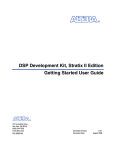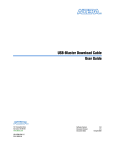Download Stratix III Development Kit User Guide
Transcript
Stratix III Development Kit User Guide 101 Innovation Drive San Jose, CA 95134 www.altera.com P25-36210-01 Document Version: Document Date: 1.1 August 2008 Copyright © 2008 Altera Corporation. All rights reserved. Altera, The Programmable Solutions Company, the stylized Altera logo, specific device designations, and all other words and logos that are identified as trademarks and/or service marks are, unless noted otherwise, the trademarks and service marks of Altera Corporation in the U.S. and other countries. All other product or service names are the property of their respective holders. Altera products are protected under numerous U.S. and foreign patents and pending applications, maskwork rights, and copyrights. Altera warrants performance of its semiconductor products to current specifications in accordance with Altera's standard warranty, but reserves the right to make changes to any products and services at any time without notice. Altera assumes no responsibility or liability arising out of the application or use of any information, product, or service described herein except as expressly agreed to in writing by Altera Corporation. Altera customers are advised to obtain the latest version of device specifications before relying on any published information and before placing orders for products or services. UG-01028-1.1 Contents Chapter 1. About This Kit Introduction . . . . . . . . . . . . . . . . . . . . . . . . . . . . . . . . . . . . . . . . . . . . . . . . . . . . . . . . . . . . . . . . . . . . . . . . . . . . 1–1 Kit Features . . . . . . . . . . . . . . . . . . . . . . . . . . . . . . . . . . . . . . . . . . . . . . . . . . . . . . . . . . . . . . . . . . . . . . . . . . . . 1–1 Documentation . . . . . . . . . . . . . . . . . . . . . . . . . . . . . . . . . . . . . . . . . . . . . . . . . . . . . . . . . . . . . . . . . . . . . . . . . 1–2 Chapter 2. Getting Started Introduction . . . . . . . . . . . . . . . . . . . . . . . . . . . . . . . . . . . . . . . . . . . . . . . . . . . . . . . . . . . . . . . . . . . . . . . . . . . . 2–1 Before You Begin . . . . . . . . . . . . . . . . . . . . . . . . . . . . . . . . . . . . . . . . . . . . . . . . . . . . . . . . . . . . . . . . . . . . . . . . 2–1 Check the Kit Contents . . . . . . . . . . . . . . . . . . . . . . . . . . . . . . . . . . . . . . . . . . . . . . . . . . . . . . . . . . . . . . . . 2–1 Inspect the Board . . . . . . . . . . . . . . . . . . . . . . . . . . . . . . . . . . . . . . . . . . . . . . . . . . . . . . . . . . . . . . . . . . . . . 2–2 Hardware Requirements . . . . . . . . . . . . . . . . . . . . . . . . . . . . . . . . . . . . . . . . . . . . . . . . . . . . . . . . . . . . . . . 2–3 Software Requirements . . . . . . . . . . . . . . . . . . . . . . . . . . . . . . . . . . . . . . . . . . . . . . . . . . . . . . . . . . . . . . . . 2–3 References . . . . . . . . . . . . . . . . . . . . . . . . . . . . . . . . . . . . . . . . . . . . . . . . . . . . . . . . . . . . . . . . . . . . . . . . . . . . . . 2–3 Chapter 3. Software Installation Introduction . . . . . . . . . . . . . . . . . . . . . . . . . . . . . . . . . . . . . . . . . . . . . . . . . . . . . . . . . . . . . . . . . . . . . . . . . . . . 3–1 Installing the Development Kit CD-ROM . . . . . . . . . . . . . . . . . . . . . . . . . . . . . . . . . . . . . . . . . . . . . . . . . . . 3–1 Installing the Quartus II DVD . . . . . . . . . . . . . . . . . . . . . . . . . . . . . . . . . . . . . . . . . . . . . . . . . . . . . . . . . . . . . 3–2 Installing the USB-Blaster Driver . . . . . . . . . . . . . . . . . . . . . . . . . . . . . . . . . . . . . . . . . . . . . . . . . . . . . . . . . . 3–3 Licensing Considerations . . . . . . . . . . . . . . . . . . . . . . . . . . . . . . . . . . . . . . . . . . . . . . . . . . . . . . . . . . . . . . . . . 3–3 Chapter 4. Development Board Setup Introduction . . . . . . . . . . . . . . . . . . . . . . . . . . . . . . . . . . . . . . . . . . . . . . . . . . . . . . . . . . . . . . . . . . . . . . . . . . . . 4–1 Requirements . . . . . . . . . . . . . . . . . . . . . . . . . . . . . . . . . . . . . . . . . . . . . . . . . . . . . . . . . . . . . . . . . . . . . . . . . . . 4–1 Powering Up the Board . . . . . . . . . . . . . . . . . . . . . . . . . . . . . . . . . . . . . . . . . . . . . . . . . . . . . . . . . . . . . . . . . . 4–1 Configuring the FPGA . . . . . . . . . . . . . . . . . . . . . . . . . . . . . . . . . . . . . . . . . . . . . . . . . . . . . . . . . . . . . . . . . . . 4–3 Chapter 5. Power Measurement Introduction . . . . . . . . . . . . . . . . . . . . . . . . . . . . . . . . . . . . . . . . . . . . . . . . . . . . . . . . . . . . . . . . . . . . . . . . . . . . 5–1 Power Design Example . . . . . . . . . . . . . . . . . . . . . . . . . . . . . . . . . . . . . . . . . . . . . . . . . . . . . . . . . . . . . . . . . . . 5–1 Measuring Power . . . . . . . . . . . . . . . . . . . . . . . . . . . . . . . . . . . . . . . . . . . . . . . . . . . . . . . . . . . . . . . . . . . . . . . 5–3 A/D Measurements . . . . . . . . . . . . . . . . . . . . . . . . . . . . . . . . . . . . . . . . . . . . . . . . . . . . . . . . . . . . . . . . . . . 5–3 Measuring Core Power . . . . . . . . . . . . . . . . . . . . . . . . . . . . . . . . . . . . . . . . . . . . . . . . . . . . . . . . . . . . . . 5–3 Measuring I/O Power . . . . . . . . . . . . . . . . . . . . . . . . . . . . . . . . . . . . . . . . . . . . . . . . . . . . . . . . . . . . . . . 5–3 Measuring Voltage with a DMM . . . . . . . . . . . . . . . . . . . . . . . . . . . . . . . . . . . . . . . . . . . . . . . . . . . . . . . . 5–4 Calculating Power . . . . . . . . . . . . . . . . . . . . . . . . . . . . . . . . . . . . . . . . . . . . . . . . . . . . . . . . . . . . . . . . . . . . 5–4 Changing the Design Example . . . . . . . . . . . . . . . . . . . . . . . . . . . . . . . . . . . . . . . . . . . . . . . . . . . . . . . . . . . . 5–5 Chapter 6. Design Tutorials Introduction . . . . . . . . . . . . . . . . . . . . . . . . . . . . . . . . . . . . . . . . . . . . . . . . . . . . . . . . . . . . . . . . . . . . . . . . . . . . 6–1 My First FPGA Tutorial . . . . . . . . . . . . . . . . . . . . . . . . . . . . . . . . . . . . . . . . . . . . . . . . . . . . . . . . . . . . . . . . . . 6–1 My First Nios II Software Tutorial . . . . . . . . . . . . . . . . . . . . . . . . . . . . . . . . . . . . . . . . . . . . . . . . . . . . . . . . . 6–1 Appendix A. Programming the Flash Device Overview . . . . . . . . . . . . . . . . . . . . . . . . . . . . . . . . . . . . . . . . . . . . . . . . . . . . . . . . . . . . . . . . . . . . . . . . . . . . . Creating a Flash File . . . . . . . . . . . . . . . . . . . . . . . . . . . . . . . . . . . . . . . . . . . . . . . . . . . . . . . . . . . . . . . . . . . . Parallel Flash Loader Instantiation . . . . . . . . . . . . . . . . . . . . . . . . . . . . . . . . . . . . . . . . . . . . . . . . . . . . . . . . Programming the Flash Device . . . . . . . . . . . . . . . . . . . . . . . . . . . . . . . . . . . . . . . . . . . . . . . . . . . . . . . . . . . © August 2008 Altera Corporation A–1 A–1 A–3 A–3 Stratix III Development Kit User Guide Preliminary iv Contents Restoring the Factory Design to the Flash Device . . . . . . . . . . . . . . . . . . . . . . . . . . . . . . . . . . . . . . . . . . . A–5 Additional Information Revision History . . . . . . . . . . . . . . . . . . . . . . . . . . . . . . . . . . . . . . . . . . . . . . . . . . . . . . . . . . . . . . . . . . . . . Info–1 How to Contact Altera . . . . . . . . . . . . . . . . . . . . . . . . . . . . . . . . . . . . . . . . . . . . . . . . . . . . . . . . . . . . . . . . Info–1 Typographic Conventions . . . . . . . . . . . . . . . . . . . . . . . . . . . . . . . . . . . . . . . . . . . . . . . . . . . . . . . . . . . . . Info–2 Stratix III Development Kit User Guide © August 2008 Altera Corporation Preliminary 1. About This Kit Introduction Welcome to the Altera® Stratix® III Development Kit, which includes a full-featured field-programmable gate array (FPGA) development board, hardware and software development tools, documentation, and accessories needed to begin FPGA development. The kit provides an integrated control environment that includes a USB command controller, a multi-port SRAM/DDR SDRAM/flash memory controller, Ethernet, an on-board meter, and example designs with demonstration circuitry specified in Verilog HDL code to help you get started quickly with your own designs. The development board includes an Altera Stratix III FPGA configured with a hardware reference design stored in flash memory. You can use the development board, along with example designs included in the kit, as a platform to prototype complex embedded systems. The development kit includes these kit features and documentation: ■ Stratix III development board ■ Altera Complete Design Suite DVD containing: ■ Quartus® II Software, Development Kit Edition (DKE) ■ MegaCore® IP Library ■ Nios® II Embedded Design Suite ■ Stratix III Development Kit CD-ROM including design examples ■ Accessory daughter cards ■ Power supply, cables, and documentation Kit Features This section briefly describes the following Stratix III Development Kit features: ■ Stratix III Development Board—a prototyping platform that allows you to develop and prototype hardware designs running on the Stratix III FPGA. f ■ © August 2008 For specific information about board components and interfaces, refer to the Stratix III Development Board Reference Manual. Quartus II Software, Development Kit Edition (DKE)—The Quartus II software (available on the DVD) provides a comprehensive environment for system-on-a-programmable-chip (SOPC) design. The Quartus II software integrates into nearly any design environment, with interfaces to industry-standard EDA tools. The kit includes: ■ The SOPC Builder system development tool ■ A one-year Quartus II software license (Windows platform only) Altera Corporation Stratix III Development Kit User Guide 1–2 Chapter 1: About This Kit Documentation f ■ The Quartus II DKE software license allows you to use the product for 12 months. After 12 months, you must purchase a renewal subscription to continue using the software. For more information, refer to the Altera website at www.altera.com. MegaCore IP Library—This library (available on the DVD) contains Altera IP MegaCore functions. You can evaluate MegaCore functions by using the OpenCore® Plus feature to do the following: ■ Simulate behavior of a MegaCore function within your system ■ Verify functionality of your design, and quickly and easily evaluate its size and speed ■ Generate time-limited device programming files for designs that include MegaCore functions ■ Program a device and verify your design in hardware 1 The OpenCore Plus hardware evaluation feature is an evaluation tool for prototyping only. You must purchase a license to use a MegaCore function in production. f For more information about OpenCore Plus, refer to AN 320: OpenCore Plus Evaluation of Megafunctions. ■ Nios II Embedded Design Suite—This full-featured set of tools (available on the DVD) allows you to develop embedded software on the Nios II processor running on Altera FPGAs. ■ Stratix III Development Kit Design Examples—The design examples (available on the CD-ROM) are useful for a variety of hardware applications and let you quickly begin board prototyping and device verification. You only need to purchase a license for a MegaCore function when you are completely satisfied with its functionality and performance, and want to take your design to production. Documentation The Stratix III Development Kit CD-ROM contains the following documents: ■ Readme.txt—Contains special instructions and refers to the kit documentation. ■ Stratix III Development Kit User Guide (this document)—Describes how to use the kit. ■ Stratix III Development Board Reference Manual—Provides specific information about the board components and interfaces, steps for using the board, and pin-outs and signal specifications. Stratix III Development Kit User Guide © August 2008 Altera Corporation 2. Getting Started Introduction This user guide familiarizes you with the contents of the kit and guides you through the Stratix III development board setup. Using this guide, you can do the following: f ■ Inspect the contents of the kit ■ Install the Altera Complete Design Suite Tools ■ Set up licensing ■ Install the Stratix III Development Kit CD-ROM ■ Set up, power up, and verify correct operation of the development board ■ Configure the Stratix III FPGA ■ Find and use the tutorials ■ Set up and run included application examples and demonstrations For complete information about the development board, refer to the Stratix III Development Board Reference Manual. Before You Begin Before using the kit or installing the software, check the kit contents and inspect the board to verify that you received all of the items listed in this section. If any of the items are missing, contact Altera before you proceed. Check the Kit Contents The Stratix III Development Kit (ordering code: DK-DEV-3SL150N) contains the following items: © August 2008 ■ Stratix III development board with an EP3SL150C3N Stratix III device ■ Altera Complete Design Suite DVD containing: ■ One-year license of Quartus II Software (DKE), Windows platform only ■ MegaCore IP Library ■ Nios II Embedded Design Suite Altera Corporation Stratix III Development Kit User Guide 2–2 Chapter 2: Getting Started Before You Begin ■ ■ Reference designs and demonstrations ■ Stratix III development kit application and device drivers ■ Design examples and tutorials ■ Stratix III Development Board Reference Manual ■ Stratix III Development Kit User Guide (this document) ■ Schematic and board design files ■ USB cable ■ Accessory daughter cards: ■ f Stratix III Development Kit CD-ROM, which includes: ■ Two loopback high-speed mezzanine connector (HSMC) cards ■ Debug HSMC card ■ 16 character × 2 line Liquid Crystal Display (LCD) ■ 128 × 64 dot matrix graphics LCD 16-V DC Power supply and adapters for North America, Europe, the United Kingdom, and Japan. To ensure that you have the most up-to-date information about this product, go to the Altera website at www.altera.com/products/devkits/altera/kit-siii-host.html. Inspect the Board Place the board on an anti-static surface and inspect it to ensure that it has not been damaged during shipment. w Without proper anti-static handling, the Stratix III development board can be damaged. Verify that all components are on the board and appear intact. 1 f In typical applications with the Stratix III development board, a heatsink is not necessary. However, under extreme conditions the board may require additional cooling to stay within operating temperature guidelines. You may wish to perform power consumption and thermal modeling to determine whether your application requires additional cooling. For more information about power consumption and thermal modeling, refer to AN 358: Thermal Management for FPGAs. Stratix III Development Kit User Guide © August 2008 Altera Corporation Chapter 2: Getting Started References 2–3 Hardware Requirements The Quartus II software has some minimum system requirements. Otherwise, the Stratix III development kit provides all of the hardware needed to use the board. f For Quartus II software requirements, refer to the Altera website at: www.altera.com/products/software/products/quartus2web/sofquarwebmain.html. Software Requirements This kit requires the following software: ■ Windows XP operating system ■ Quartus II software (refer to the readme.txt file on the CD-ROM for specific version requirements) References For other related information, refer to the following websites: ■ For additional daughter cards available for purchase: www.altera.com/products/devkits/kit-daughter_boards.jsp ■ For the Stratix III device documentation: www.altera.com/literature/lit-stx3.jsp ■ For eStore if you want to purchase devices: www.altera.com/buy/devices/buy-devices.html ■ For Stratix III Orcad symbols: www.altera.com/support/software/download/pcb/pcb-pcb_index.html ■ For Nios II 32-bit embedded processor solutions: www.altera.com/technology/embedded/emb-index.html © August 2008 Altera Corporation Stratix III Development Kit User Guide 2–4 Stratix III Development Kit User Guide Chapter 2: Getting Started References © August 2008 Altera Corporation 3. Software Installation Introduction The instructions in this section explain how to install the following: 1 ■ Stratix III Development Kit CD-ROM ■ Stratix III Development Kit demo application and drivers ■ The Quartus II Software (DKE) on the DVD, including MegaCore functions from the MegaCore IP Library Before starting the installation, verify that you have complied with the conditions described in “Software Requirements” on page 2–3. Installing the Development Kit CD-ROM The Stratix III Development Kit CD-ROM contains the following items: ■ The sample design and board design files ■ Quick Start Guide ■ My First FPGA Tutorial ■ My First Nios II Software Tutorial ■ Stratix III Development Kit User Guide (this document) ■ Stratix III Development Board Reference Manual To install the Stratix III Development Kit CD-ROM, perform the following steps: 1. Insert the Stratix III Development Kit CD-ROM into the CD-ROM drive. 1 The CD-ROM should start an auto-install process. If it does not, browse to the CD-ROM drive and double-click on the setup.exe file. 2. Follow the on-screen instructions to complete the installation process. The installation program copies the Stratix III development kit files to an installation directory on the computer hard disk and creates a Programs > Altera > Stratix III Development Kit <version#> Windows Start menu shortcut. Use this shortcut later to launch the development kit graphical user interface (GUI). The installation program creates the directory structure shown in Figure 3–1 for the Stratix III development kit files. In this user guide, <path> refers to <installation directory>\stratixIII_3sl150_dev when locating the development kit files. © August 2008 Altera Corporation Stratix III Development Kit User Guide 3–2 Chapter 3: Software Installation Installing the Quartus II DVD Figure 3–1. Stratix III Development Kit Installed Directory Structure <path> The default Windows installation directory is C:\altera\<version#>\kits. stratixIII_3sl150_dev board_design_files demos documents examples factory recovery Table 3–1 lists the file directory names and a description of their contents. Table 3–1. Installed Directory Contents Directory Name Description of Contents board_design_files Contains schematic, layout, assembly, and bill of material board design files. Use these files as a starting point for a new prototype board design. demos Contains demonstration applications that may change from release to release. documents Contains the development kit documentation. examples Contains the sample design files for the Stratix III Development Kit. factory recovery Contains the original data programmed onto the board before shipment. Use this data to put the board into the original condition. 1 The examples directory contains a golden top project example with all the pin-out and pin configuration information included. Installing the Quartus II DVD The Quartus II software is the primary FPGA development tool used to create the reference designs in this development kit. Additionally, you may want to install the Nios II Embedded Design Suite found in the Altera Complete Design Suite at www.altera.com/support/software/download/nios2/dnl-nios2.jsp. The Nios II embedded processor runs on Altera FPGAs. Some of the reference designs included in this development kit use the Nios II processor. Insert the Altera Complete Design Suite DVD into the DVD drive, and click Install subscription package on the startup window. Follow the on-screen instructions and accept all default settings. After installing the software, request and install a license to enable it. f For information about obtaining a license file, refer to “Licensing Considerations” on page 3–3. Stratix III Development Kit User Guide © August 2008 Altera Corporation Chapter 3: Software Installation Installing the USB-Blaster Driver 3–3 Installing the USB-Blaster Driver The Stratix III development board includes integrated USB-Blaster™ circuitry for FPGA programming. However, for the host computer and development board to communicate, you must install the USB-Blaster driver on the host computer. f To download the USB-Blaster driver, go to the Altera support site at www.altera.com/support/software/drivers/dri-index.html. To install it, go to www.altera.com/support/software/drivers/usb-blaster/dri-usbblaster-xp.html. Licensing Considerations Before using the Quartus II software, you must request a license file from the Altera website at www.altera.com/licensing and install it on your computer. When you request a license file, Altera emails you a license.dat file that enables the software. To license the Quartus II software, you need your network interface card (NIC) ID, which is a 12-digit hexadecimal number that identifies your computer. Networked (or floating-node) licensing requires a NIC ID or server host ID. When obtaining a license file for network licensing, use the NIC ID from the computer that issues the Quartus II licenses to distributed users over a network. You can find the NIC ID for your card by typing ipconfig/all at a command prompt. Your NIC ID is the number on the physical address line, without the dashes. To obtain a license, perform the following steps. 1. Go to the Altera website at www.altera.com/support/licensing/lic-choose.html. 2. Under Development Kit Licenses Request, click Licenses for RoHS-Compliant Kits. 3. Follow the on-screen instructions to request your license. You will receive a license file through email. 1 Before installing your license, close the following software if it is running on your computer: ■ Quartus II software ■ MAX+PLUS® II software ■ LeonardoSpectrum™ synthesis tool ■ Synplify software ■ ModelSim® simulator ■ Precision RTL Synthesis Software 4. To install your license, refer to the Specifying the License File section in the Quartus II Installation & Licensing for Windows Manual, which is included with the kit. © August 2008 Altera Corporation Stratix III Development Kit User Guide 3–4 Stratix III Development Kit User Guide Chapter 3: Software Installation Licensing Considerations © August 2008 Altera Corporation 4. Development Board Setup Introduction The instructions in this chapter explain how to install the development board and configure the FPGA. Requirements Before starting the installation, verify that you have complied with the conditions described in “Hardware Requirements” on page 2–3 and have completed the following requirements: 1 ■ Quartus II software installed on the host computer ■ USB-Blaster driver software installed on the host computer. The Stratix III development board includes integrated USB-Blaster circuitry for FPGA programming. Host computer and development board cannot communicate without the USB-Blaster driver software installed. For installation information, refer to “Installing the USB-Blaster Driver” on page 3–3. Powering Up the Board Figure 4–1 shows the Stratix III development board and its components. © August 2008 Altera Corporation Stratix III Development Kit User Guide 4–2 Chapter 4: Development Board Setup Powering Up the Board Figure 4–1. Stratix III Development Board Layout and Components JTAG Control DIP Switch (SW1) QDRII+ SRAM (U15) (Behind the LCD Screen) Speaker Header (J1) Stratix III FPGA (U22) 24 MHz Crystal (Y4) 125 MHz MAX II Clock (Y1) Device Select (J2) Jumper MAX II CPLD (U5) Flash Memory Device (U9) Type B USB Connector (J5) 24 MHz Crystal (Y2) HSMC Port B TX/RX Activity LEDs (D2, D3) 6 MHz Crystal (Y3) DDR2 SDRAM (U17, U20) MAX II Control DIP Switch (SW2) HSMC Port B (J8) PGM Config Select Rotary Switch (SW3) HSMC Port B Present LED (D10) Ethernet PHY LEDs (D6, D7, D8) and Duplex LED (D9) MSEL0 to GND Jumper (J13) RJ-45 Ethernet Connector (J14) HSMC Port A TX/RX Activity LEDs (D11, D12) Ethernet PHY TX/RX Activity LEDs (D14, D15) Clock In/Out SMAs (J16, J17) HSMC Port A (J18) Factory Configuration Push Button (S1) HSMC Port A Present LED (D17) Power LED (D16) Power Switch (SW4) DC Power Jack (J21) Power Display (U27) User Display (U28) User DIP Switch (SW5) User Push Buttons (S2 through S5) Configuration Done LED (D32) DDR2 SDRAM DIMM Connector (J19) Power Select Rotary Switch (SW6) Board-Specific LEDs (D33-D36) Reset Configuration Push Button (S7) User LEDs (D20 through D27) CPU Reset Push Button (S6) Before powering up, prepare the board as follows: 1. If cards are plugged into the HSMC ports, remove them. 2. Ensure that the POWER switch SW4 is in the OFF (or DOWN) position. 3. Configure the 8-position SW2 DIP switch to the default settings in Table 4–1. Table 4–1. Switch SW2 Settings (Part 1 of 2) Function Switch Name Position 0 Position 1 Default Position mW mA 0 V W 1 1 mW/mA 2 V/W 3 RSV0 MAX_RESERVE0 X 4 RSV1 MAX_RESERVE1 X Stratix III Development Kit User Guide © August 2008 Altera Corporation Chapter 4: Development Board Setup Configuring the FPGA 4–3 Table 4–1. Switch SW2 Settings (Part 2 of 2) Function Switch Name Position 0 Position 1 PFL Disable Default Position 5 MAX0 PFL Enable 1 6 MAX1 MAX_DIP1 X 7 MAX2 MAX_DIP2 X 8 MAX3 MAX_DIP3 X Note to Table 4–1: (1) X = don’t care 4. Ensure that the 4-position SW1 mini-DIP switches and the two jumpers are set to the default positions shown in Table 4–2. Table 4–2. Initial Switch and Jumper Settings DEV_SEL-J2 JTAG_SEL-J3 SW1.1 SW1.2 SW1.3 SW1.4 ON ON ON OFF OFF OFF 5. Ensure that the J13 MSEL0 GND jumper is ON. 6. Verify that the PGM CONFIG SELECT rotary switch SW3 is set to 0. At power up, the development board uses a preloaded configuration to demonstrate that the board is operating correctly. Power up the development board by performing the following steps: 1. Connect the 16-V DC adapter to the development board and to a power source. w Use only the supplied 16-V power supply. Power regulation circuitry on the board could be damaged by supplies greater than 16 V. 2. Slide the POWER switch to ON. The nearby blue POWER light-emitting diode (LED) lights up. 3. Confirm that user LEDs 0-7 flash in a scrolling, side-to-side pattern. For customized configurations, the pattern depends on the application. f For information about custom configurations, refer to “Programming the Flash Device” on page A–3. Configuring the FPGA Before configuring the FPGA, ensure that the Quartus II software and the USB-Blaster driver software are installed on the host computer and the development board is powered on. f © August 2008 For USB-Blaster driver installation information, refer to “Installing the USB-Blaster Driver” on page 3–3. Altera Corporation Stratix III Development Kit User Guide 4–4 Chapter 4: Development Board Setup Configuring the FPGA To configure the Stratix III FPGA, perform the following steps: 1. Verify that the 4-position SW1 mini-DIP switches and the two jumpers are set to the default positions shown in Table 4–2. 2. Connect the USB cable to the development board USB port. 3. Cycle the POWER switch OFF then ON. 4. Start the Quartus II software. 5. On the Tools menu, click Programmer. The Quartus II Programmer appears. 6. Click Add File and select <path>\examples\stratixIII_3sl150_dev_my_first_fpga \stratixIII_3sl150_dev_my_first_fpga.sof. 7. Turn on the Program/Configure option for the added file. 8. Click Start to download the selected file to the FPGA. The FPGA is configured when the progress bar reaches 100%. 9. Confirm that user LEDs 0-3 flash in a slow binary counting pattern. Stratix III Development Kit User Guide © August 2008 Altera Corporation 5. Power Measurement Introduction One of the main features of the Stratix III FPGA device is its low power consumption. You can measure the power used by the 3SL150 FPGA device on the Stratix III development board for various conditions with a power design example provided with the kit. With the power design example, you can control the amount of logic utilized in the FPGA, the clock frequency, and the number of I/Os used, and measure the effect on power used by the Stratix III device. Power Design Example The power design example uses a replicated module, stamp.v, that contains combinational logic, randomly filled ROMs, multiplier blocks, and shift registers that change with every clock cycle. The frequency and resource states indicated in Table 5–2 and Table 5–3 on page 5–2, respectively, represent the percent of full design used. As compiled, the full example design uses the following FPGA resources: ■ Combinational adaptive look-up tables (ALUTs): 1,872 / 113,600 (2%) ■ Dedicated logic registers: 106,640 / 113,600 (94%) ■ Total registers: 106,640 ■ Total pins: 173 / 744 (23%) ■ Total memory bits: 2,621,440 / 5,630,976 (47%) ■ Embedded multiplier 18-bit elements: 320 / 384 (83%) ■ Total PLLs: 1/8 (13%) Table 5–1 describes the functionality of the four user push buttons that control the power design example. The on-board 50-MHz oscillator provides the input clock (i_clk, PIN_T33). Table 5–1. Four Input Button Functionality User Push Button FPGA Pin User_PB0 B17 Reset Resets the demo to the beginning, i_nrst User_PB1 A17 Toggle Advances the design example to the next higher frequency, i_nfreq_next User_PB2 A16 Toggle Advances the design example to the next higher resource utilization, i_nperc_next User_PB3 K17 Toggle Enables the outputs to toggle, i_noutput_ena © August 2008 Type Altera Corporation Description Stratix III Development Kit User Guide 5–2 Chapter 5: Power Measurement Power Design Example The LEDs in Table 5–2 indicate the power-state values of the design example as User_PB1 advances frequency. Table 5–2. Power State Indicators for Frequency LED1 (C23) LED0 (F21) Frequency (MHz) 0 0 0 0 1 33 1 0 67 1 1 100 The LEDs in Table 5–3 indicate the power-state values of the design example (and number of output pins, when enabled by User_PB3) as User_PB2 advances resource utilization. Table 5–3. Power State Indicators for Resources LED6 (F19) LED5 (C19) LED4 (D19) LED3 (A23) LED2 (B23) Resources (%) Number of Outputs 0 0 0 0 0 5 8 0 0 0 0 1 10 16 0 0 0 1 0 15 24 0 0 0 1 1 20 32 0 0 1 0 0 25 40 0 0 1 0 1 30 48 0 0 1 1 0 35 56 0 0 1 1 1 40 64 0 1 0 0 0 45 72 0 1 0 0 1 50 80 0 1 0 1 0 55 88 0 1 0 1 1 60 96 0 1 1 0 0 65 104 0 1 1 0 1 70 112 0 1 1 1 0 75 120 0 1 1 1 1 80 128 1 0 0 0 0 85 136 1 0 0 0 1 90 144 1 0 0 1 0 95 152 1 0 0 1 1 100 160 The resource state (Table 5–3) controls the number of I/O pins used. Each resource increment adds eight additional I/O pins (Table 5–3). Similarly, the overall design frequency (Table 5–2) sets the toggle frequency of these I/O pins. Stratix III Development Kit User Guide © August 2008 Altera Corporation Chapter 5: Power Measurement Measuring Power 5–3 Measuring Power You can measure power by using the analog-to-digital (A/D) circuitry on the development board or by using a digital multimeter (DMM) across on-board sense resistors. However, note that, depending on the DMM accuracy, the on-board A/D measurements tend to produce considerably more accurate results. A/D Measurements The POWER SELECT rotary switch SW6 sets the development board to measure and display FPGA core power or I/O output power (Table 5–4). Table 5–4. Switch SW6 Power Selection Switch Position FPGA Power I/O Bank 0 Core: VCCL, TBD V — 7 I/O: 2.5 V 2 8 I/O: 2.5 V 4, 5, and 6 Measuring Core Power To measure FPGA core power for various power states, perform the following steps: 1. Ensure that the 8-position SW2 DIP switch is configured to the default settings shown in Table 4–1 on page 4–2. 2. Download the stratixIII_dev_power.sof file as described in “Configuring the FPGA” on page 4–3. The power design example is in <path>\demos\stratixIII_3sl150_dev_power. 3. Set the POWER SELECT rotary switch SW6 to 0 to measure the internal VCC_INT power in watts. 4. Observe the power on the 4-digit hexadecimal POWER DISPLAY. 5. Using the user input push buttons (Table 5–1 on page 5–1), advance through the power states in Table 5–2 and Table 5–3 on page 5–2. Notice how power increases as frequency and resources increase. Measuring I/O Power This example uses FPGA I/O banks 2, 4, 5, and 6. Using the SW6 settings (Table 5–4), measure the power for I/O banks 4, 5, and 6, then for I/O bank 2, by performing the following steps: 1. Ensure that the 8-position SW2 DIP switch is configured to the default settings shown in Table 4–1 on page 4–2. 2. Download the stratixIII_dev_power.sof file as described in “Configuring the FPGA” on page 4–3. The power design example is in <path>\demos\stratixIII_3sl150_dev_power. 3. Set the POWER SELECT rotary switch SW6 to 8. 4. Observe the 4-digit hexadecimal POWER DISPLAY for the I/O output power in watts on banks 4, 5, and 6. © August 2008 Altera Corporation Stratix III Development Kit User Guide 5–4 Chapter 5: Power Measurement Measuring Power 5. Using the user input push buttons (Table 5–1 on page 5–1), advance through the power states in Table 5–2 and Table 5–3 on page 5–2. Notice how power increases as frequency and resources increase. 6. Press the User_PB3 button to enable the output pins on the HSMC connectors J8 and J18. LED7 (E19), signal o_noutput_ena_state, lights to indicate that the outputs are enabled and toggling. Enabling the outputs further increases power for each resource utilization percentage used by the Stratix III FPGA. 7. Press the User_PB3 button again to disable the outputs. LED7 turns off. 8. Set the POWER SELECT rotary switch SW6 to 7. 9. Repeat steps 4 through 7 to observe the I/O output power in watts on bank 2. The sum of power results from the two sets of I/O banks provides the total FPGA I/O power. f For specific information about on-board measurements and the POWER SELECT rotary switch, refer to the Stratix III Development Board Reference Manual. Measuring Voltage with a DMM To obtain power values by using a DMM, measure voltage across the sense-resistors, R215, R218, and R214 on the board, then use the voltage measurements to calculate power. 1 For best results, use a DMM with six-digit or greater accuracy. FPGA I/O power is distributed by banks (Table 5–5), for which the sense resistors are components R218 and R214. For the I/O power calculation, use the sum of voltage measurements across these resistors while outputs are enabled. For the FPGA core power calculation, measure the sense resistor voltage across R215. Table 5–5. Sense Resistors Voltage Sense Resistor Resistor Value Bank 2 2.5 V R214 0.009 Ω Banks 4, 5 and 6 2.5 V R218 0.009 Ω 1.1 V R215 0.009 Ω FPGA Power I/O Core: VCCL Calculating Power To obtain the power P in watts, measure the voltage across the sense resistors, VSENSE, and calculate the nominal power as follows: If VSENSE = Voltage measured across the sense resistor ISENSE = Current through the sense resistor VSUPPLY = FPGA supply voltage RSENSE = Sense resistor value in Table 5–5. Stratix III Development Kit User Guide © August 2008 Altera Corporation Chapter 5: Power Measurement Changing the Design Example 5–5 then Equation 5–1. V SUPPLY × V SENSE P = VI = V SUPPLY × I SENSE = --------------------------------------------R SENSE where VSUPPLY is 1.1 V for the FPGA core and 2.5 V for FPGA I/O. Voltage measurements on the DMM should increase as frequency and resource utilization increases according to Table 5–2 and Table 5–3 on page 5–2. Changing the Design Example The development kit includes source code for the Stratix III power design example so you can use it as a starting point for your own measurements. The design example uses 20 stamp.v modules, each with 8 outputs, for a total of 160 output pins. It assigns the pins selected as outputs to the HSMC connectors J8 and J18. To change the number of outputs, modify the design example and assign the pins appropriately. 1 © August 2008 Power should track linearly with frequency and percentage resources. If you observe superlinear power measurements, some temperature issue may be the cause. Altera Corporation Stratix III Development Kit User Guide 5–6 Stratix III Development Kit User Guide Chapter 5: Power Measurement Changing the Design Example © August 2008 Altera Corporation 6. Design Tutorials Introduction The example designs and tutorials included in the Stratix III Development Kit help familiarize new users with development board features. My First FPGA Tutorial and My First Nios II Software Tutorial provide step-by-step guidance for the first-time user. My First FPGA Tutorial My First FPGA Tutorial describes how to create a simple Altera FPGA design. The tutorial takes less than an hour to complete and provides an overview of the design flow using Quartus II software to build a simple logic counter which drives LEDs to flash on the development board. After installing the Stratix III Development Kit CD-ROM, the My First FPGA Tutorial design and documentation can be found at: <path>\documents\tutorials\hardware_tutorials\my_first_fpga_tutorial.pdf. My First Nios II Software Tutorial My First Nios II Tutorial introduces the basic system development flow for the Nios II processor. This tutorial provides a good starting point if you are new to the Nios II processor or to the general concept of using an embedded processor in an FPGA. In this tutorial, you use a standard, existing Nios II hardware system and create a software program to run on it. After installing the Stratix III Development Kit CD-ROM, the My First Nios II Software Tutorial design and documentation can be found at: <path>\documents\tutorials\software_tutorials\my_first_nios2_software_tutorial .pdf. © August 2008 Altera Corporation Stratix III Development Kit User Guide 6–2 Stratix III Development Kit User Guide Chapter 6: Design Tutorials My First Nios II Software Tutorial © August 2008 Altera Corporation A. Programming the Flash Device Overview There is a Common Flash Interface (CFI) type flash memory device on the Stratix III development board. When you first receive the kit, this CFI flash device arrives programmed with a default factory configuration that was loaded from a Programmer Object File (.pof). When you power up the board, the CFI flash device configures the FPGA with the default factory configuration using Fast Passive Parallel (FPP) programming. If the configuration loads correctly, the user LEDs on the board flash sequentially from side to side. As you develop your own project using the Altera tools, you may wish to program the flash device so that, upon power up, it loads the FPGA with your own design. Or you may wish to restore the default factory configuration to your board. This appendix describes how to program the flash device. You can load an existing design from a .pof, but if your design exists only as an SRAM Object File (.sof), then first you must convert the .sof to a .pof. Programming the flash device also requires the use of the Altera parallel flash loader (PFL). Using this appendix, you can do the following: ■ Create a flash file by converting a .sof to .pof ■ Install the PFL ■ Use the Quartus II Programmer to write a .pof to the flash device ■ Restore the default factory configuration Creating a Flash File To create a flash-programmable configuration .pof, perform the following steps: 1. On the File menu in the Quartus II software, click Convert Programming Files. 2. In the Convert Programming Files dialog box, specify the parameter values as shown in the following table: Parameter Value Programming file type Programmer Object File (.pof) Configuration device CFI_512MB Mode Fast Passive Parallel File name <output_file.pof> This is the default file name. Change this to the file name you wish to use for your application. Save the file in <path>\examples\stratixIII_3sl150_dev_pfl. Memory Map File © August 2008 Altera Corporation selected (default) Stratix III Development Kit User Guide A–2 Appendix A: Programming the Flash Device Creating a Flash File 3. Click Options. In the Options dialog box, type 0x3FE0000 then click OK. This sets the option bit base address for the development kit to the required default, 0x3FE0000. The option bit sector stores the start address for each page of memory and also stores the Page Valid bits. The Page Valid bits indicate whether each page is successfully programmed. f For more information about option bits and Page Mode Implementation of memory, refer to AN 386: Using the Parallel Flash Loader with the Quartus II Software. 4. Choose the .sof file you want to convert by selecting the row labeled SOF Data in the Input files to convert area, and click Add File. 5. Browse to and select the file you wish to convert and click OK. Figure A–1 shows the Convert Programming Files dialog box updated with the factory image your_design_name.sof. 1 If you choose to overwrite an existing .pof file, you receive a warning message. Figure A–1. Convert Programming Files Settings Stratix III Development Kit User Guide © August 2008 Altera Corporation Appendix A: Programming the Flash Device Parallel Flash Loader Instantiation A–3 6. Click Generate. Generation takes a short time and it is confirmed by a “Generated… pof successfully” message. You now have a successfully generated .pof that can be programmed to the flash device to automatically configure the FPGA on your Stratix III development board. Parallel Flash Loader Instantiation The development kit includes a PFL megafunction design, stratixIII_3sl150_dev_pfl, in the directory <path>\examples. The Quartus II software uses the PFL to write programming files to the flash device, which then loads the FPGA on power up. To write to a flash device, you must first program the PFL into the FPGA by using the Quartus II software as described in “Programming the Flash Device” on page A–3, steps 1 through 8. f For more information about the PFL megafunction, refer to AN 386: Using the Parallel Flash Loader with the Quartus II Software. Programming the Flash Device To program the flash device on the development board, you must first create a .pof flash file as described in “Creating a Flash File” on page A–1. The following procedure describes programming the PFL into the FPGA, then uses the PFL to write the .pof flash file into the flash device. To download a configuration bit stream into the flash device, perform the following steps: 1. Ensure that the POWER switch SW4 is in the OFF (or DOWN) position. 2. Verify the switch SW1 and jumper settings shown in Table 4–2 on page 4–3. 3. Connect the USB cable to the USB port on the board. 4. Cycle the POWER switch OFF then ON. 5. On the Tools menu in the Quartus II software, click Programmer. 6. Click Add File and select <path>\examples\stratixIII_3sl150_dev_pfl\stratixIII_3sl150_dev_pfl.sof. 7. Turn on the Program/Configure option for the added file. 8. Click Start to download the selected configuration file to FPGA (Figure A–2). The FPGA is configured when the progress bar reaches 100%, after which it is ready to access and program the flash device. © August 2008 Altera Corporation Stratix III Development Kit User Guide A–4 Appendix A: Programming the Flash Device Programming the Flash Device Figure A–2. PFL Programming 9. Click Auto Detect. The EP3SL150 device and a child CFI_512MB device appear in the list of devices to be programmed. 10. Double-click the <File><none> field of the CFI_512MB row. The Select New Programming File dialog box appears. Select the desired .pof, in this example the <output_file>.pof flash file you created earlier, and click Open. 11. Turn on Page_0 and OPTION_BITS options in the Program/Configure column that correspond to the CFI_512MB device (Figure A–3). This results in writes only to the flash page zero and the option bit register. Stratix III Development Kit User Guide © August 2008 Altera Corporation Appendix A: Programming the Flash Device Restoring the Factory Design to the Flash Device A–5 Figure A–3. Program/Configure Options 12. Click Start. The message window details the flash writing progress to successful completion. Flash writing to one page, as in this case, can take five to six minutes. You have now successfully programmed the flash device with a configuration for your board. To configure the board from the flash device, power cycle the board as described in “Powering Up the Board” on page 4–1. Powering on the board causes the flash device to load a new configuration into the FPGA device. The CONF DONE LED lights up and the hardware functions associated with the design take effect. Restoring the Factory Design to the Flash Device To restore the development board to factory conditions, repeat the steps for writing a new .pof to the flash device as described in “Programming the Flash Device” on page A–3, except select the stratixIII_3sl150_dev_factory_recovery.pof file. © August 2008 Altera Corporation Stratix III Development Kit User Guide A–6 Stratix III Development Kit User Guide Appendix A: Programming the Flash Device Restoring the Factory Design to the Flash Device © August 2008 Altera Corporation Additional Information Revision History The following table displays the revision history for this user guide. Date August 2008 October 2007 Version 1.1 1.0 Changes Made ■ Updated “Introduction” section. ■ Under “Kit Features” and “Software Requirements” sections, removed references to Quartus II Software Web Edition and added information about the availability of the Quartus II Software Dev Kit Edition where appropriate. ■ Updated directory structure and information about the directory contents in Figure 3–1 and Table 3–1, respectively. ■ Removed Figure 3-2 and Figure 4-2. ■ Corrected POWER SELECT rotary switch SW4 to SW6 in “Measuring Power” section. ■ Converted document to new frame template and made textual and style changes. First publication How to Contact Altera For the most up-to-date information about Altera products, refer to the following table. Contact Note 1 Contact Method Address Technical support Website www.altera.com/support Technical training Website www.altera.com/training Email [email protected] Website www.altera.com/literature Product literature Non-technical support (General) Email (Software Licensing) Email [email protected] [email protected] Note to Table: (1) You can also contact your local Altera sales office or sales representative. © August 2008 Altera Corporation Stratix III Development Kit User Guide Info–2 Additional Information Typographic Conventions Typographic Conventions This document uses the typographic conventions shown in the following table. Visual Cue Meaning Bold Type with Initial Capital Letters Command names, dialog box titles, checkbox options, and dialog box options are shown in bold, initial capital letters. Example: Save As dialog box. bold type External timing parameters, directory names, project names, disk drive names, filenames, filename extensions, and software utility names are shown in bold type. Examples: fMAX, \qdesigns directory, d: drive, chiptrip.gdf file. Italic Type with Initial Capital Letters Document titles are shown in italic type with initial capital letters. Example: AN 75: High-Speed Board Design. Italic type Internal timing parameters and variables are shown in italic type. Examples: tPIA, n + 1. Variable names are enclosed in angle brackets (< >) and shown in italic type. Example: <file name>, <project name>.pof file. Initial Capital Letters Keyboard keys and menu names are shown with initial capital letters. Examples: Delete key, the Options menu. “Subheading Title” References to sections within a document and titles of on-line help topics are shown in quotation marks. Example: “Typographic Conventions.” Courier type Signal and port names are shown in lowercase Courier type. Examples: data1, tdi, input. Active-low signals are denoted by suffix n, e.g., resetn. Anything that must be typed exactly as it appears is shown in Courier type. For example: c:\qdesigns\tutorial\chiptrip.gdf. Also, sections of an actual file, such as a Report File, references to parts of files (e.g., the AHDL keyword SUBDESIGN), as well as logic function names (e.g., TRI) are shown in Courier. 1., 2., 3., and a., b., c., etc. Numbered steps are used in a list of items when the sequence of the items is important, such as the steps listed in a procedure. ■ Bullets are used in a list of items when the sequence of the items is not important. ● • v The checkmark indicates a procedure that consists of one step only. 1 The hand points to information that requires special attention. c The caution calls attention to a condition that could damage the product or design and should be read prior to starting or continuing with the procedure or process. w The warning calls attention to a condition that could cause injury to the user and should be read prior to starting or continuing the procedure or processes. r The angled arrow indicates you should press the Enter key. f The feet direct you to more information on a particular topic. Stratix III Development Kit User Guide © August 2008 Altera Corporation


































